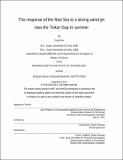The response of the Red Sea to a strong wind jet near the Tokar Gap in summer
Author(s)
Zhai, Ping, Ph. D. Massachusetts Institute of Technology
DownloadFull printable version (2.564Mb)
Other Contributors
Woods Hole Oceanographic Institution.
Advisor
Amy Bower.
Terms of use
Metadata
Show full item recordAbstract
Remote sensing and in situ observations are used to investigate the ocean response to the Tokar Wind Jet in the Red Sea. The wind jet blows down the pressure gradient through the Tokar Gap on the Sudanese coast, at about 18°N, during the summer monsoon season. It disturbs the prevailing along-sea (southeastward) winds with strong cross-sea (northeastward) winds that can last from days to weeks and reach amplitudes of 20-25 m/s. By comparing scatterometer winds with along-track and gridded sea level anomaly observations, it is shown that an intense dipolar eddy spins up in less than seven days in response to the wind jet. The eddy pair has a horizontal scale of 140 km. Maximum ocean surface velocities can reach 1 m/s and eddy currents extend at least 200 m into the water column. The eddy currents appear to cover the width of the sea, providing a pathway for rapid transport of marine organisms and other drifting material from one coast to the other. Interannual variability in the strength of the dipole is closely matched with variability in the strength of the wind jet. The dipole is observed to be quasi-stationary, although there is some evidence for slow eastward propagation-simulation of the dipole in an idealized high-resolution numerical model suggests that this is the result of self-advection. These and other recent in situ observations in the Red Sea show that the upper ocean currents are dominated by mesoscale eddies rather than by a slow overturning circulation.
Description
Thesis (S.M.)--Joint Program in Oceanography/Applied Ocean Science and Engineering (Massachusetts Institute of Technology, Dept. of Earth, Atmospheric, and Planetary Sciences; and the Woods Hole Oceanographic Institution), 2011. This electronic version was submitted by the student author. The certified thesis is available in the Institute Archives and Special Collections. Cataloged from PDF version of thesis. Includes bibliographical references (p. 63-65).
Date issued
2011Department
Joint Program in Oceanography/Applied Ocean Science and Engineering; Woods Hole Oceanographic Institution; Massachusetts Institute of Technology. Department of Earth, Atmospheric, and Planetary SciencesPublisher
Massachusetts Institute of Technology
Keywords
Joint Program in Oceanography/Applied Ocean Science and Engineering., Earth, Atmospheric, and Planetary Sciences., Woods Hole Oceanographic Institution.